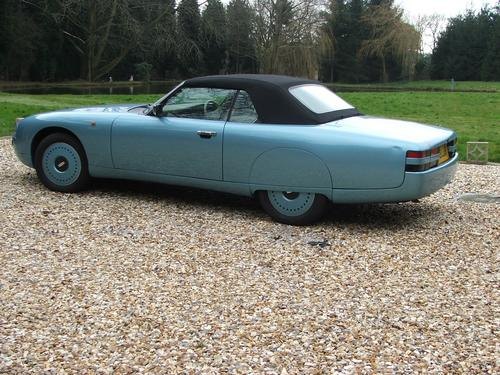Never Mind The DB7, Here's The Railton

Psst! Hey, you! Yes, you! The guy with the gold Bentley-By-Breitling-Celebrating-Bentley-Brand-Breitlings diamond-studded watch! With your arm around two Estonian working girls! I know you’re about to step into a fresh new Aston Vanquish, but perhaps Sir would be interested in something authentically English and genuinely bespoke? An individual creation from a man whose contribution to the automotive design scene is beyond question, a man who designed the car to which your current matte-finished whip is about to pay homage? Surely you’re interested, right? And here’s the good news: it’s far too expensive!
Sir William Towns designed a few extremely important Aston Martins, including the original, no-Daniel-Craig-involvement DBS, the stunning Lagonda sedan, and the stunningly techno-vicious Bulldog. Having moved on to industrial design in his fifties, he remained interested in opportunities to design cars. Therefore, when he found some money in the form of LPG drilling impresario John Ranson, he returned to the field with a concept for a uniquely British luxury “drophead”.
The name of the brand, Railton, was a “reboot” designed to honor English automotive pioneer Reid Railton. Mr. Railton’s career spanned nearly forty years and peaked with the postwar Railton Mobil Special which eventually broke the 400mph barrier. He put his name on a variety of production cars but apparently limited his activites after World War II to the land-speed-record cars. His death in 1977 apparently freed Towns to use the name, along with the Fairmile and Claremont model named.
If you hadn’t figure it out already, seeing the interior shot should clinch it for you: the Railton was a rebodied Jaguar XJ-S. By 1991, the year of the Railton’s debut, the XJ-S was already a sixteen-year-old car riding on a twenty-four-year-old platform, but the resurgent Egan-era Jaguar had done a lot to make it livable, enjoyable, and somewhat reliable. One prototype was built of both the Fairmile and Claremont. The Claremont is the one you see here, and Towns retained possession of it until his death. The Fairmile, which was displayed at a variety of auto shows, was the same car without the wheel spats. Construction was handled by Park Street Metal, which also built the Jaguar XJ220 in series production. The bodywork was hand-beaten from aluminum panels, just the way you’d expect.
The intended price for the Claremont was 105,000 pounds, which would be roughly equivalent to $280,000 today. Let’s call it $279,999. Heavy bread for a Jag, and about four times what the donor car cost.
Performance Car, which became EVO later on in life, tested the blue Railton Claremont in company with three “tuner” XJ-S variants and were utterly scathing about its eight-plus-second 0-60 time and ocean-liner handling. They much preferred the big-bore Lister XJ-S with its 911-Turbo-rivaling performance, of course. The Railton made no sense to them. The project did not continue past the production of the first two cars, probably for lack of dealer interest.
Towns’ death in 1993 eventually sent the Claremont to the auction block in 2002, where it fetched an undisclosed amount that was surely far short of its original cost to create. To the modern eye, the car looks sleek, restrained, and unabashedly upscale. At the time, however, the buyers for cars in this price range wanted something that was either supercar fast or not easily identified as a Jaguar XJ-S in a new suit. Lister sold plenty of pumped-up Jags but Railton couldn’t sell a single classed-up one.
As usual, there’s a slightly ironic postscript to this story. The ancient XJ-S didn’t find a new career under the hand-beaten panels of a Railton Claremont, but it did find redemption as the basis for the 1994 Aston Martin DB7. That particular Jag-in-drag saved the Aston brand and ensured that it survived long enough to become a trinket for Kuwaiti investors with a fetish for pumped-up homages to the Towns-penned DBS. The XJ-S also served to underpin the first-generation XK8 which was a tremendous success as well and did quite a bit to restore the dimmed luster of the Jaguar brand in the United States. Surely there’s a bit of Railton in the XK8’s over-long overhangs, a little touch of William in the night?
It would be nice to think that perhaps the name could see a third age, a venture-capital revival to produce a hand-beaten aluminum drophead for the oil-rich Moscovites and Saudis who stand so prominently in the roster of the newly wealthy, but such a vehicle would have to compete with all the faux-British luxury iron already on the market. Why buy a Railton when the Phantom Drophead has such star quality? It’s a shame. Still, for the genuine enthusiast, it’s still possible to get most of the Railton experience for a fraction of the cost: just try a solid-condition XJ-S HE. British motoring at its best, or perhaps its worst, but truly British for all that.

More by Jack Baruth
Latest Car Reviews
Read moreLatest Product Reviews
Read moreRecent Comments
- MaintenanceCosts The crossover is now just "the car," part 261.
- SCE to AUX I'm shocked, but the numbers tell the story.
- SCE to AUX "If those numbers don’t bother you"Not to mention the depreciation. But it's a sweet ride.
- Shipwright Great news for those down south. But will it remove internal heat to the outside / reduce solar heat during cold winter months making it harder to keep the interior warm.
- Analoggrotto Hyundai is the greatest automotive innovator of the modern era, you can take my word for it.





































Comments
Join the conversation
Oh Boy! Another weird, expensive British car essentially built in a shed. Nothing new, time to move on.
Am I the only one who's getting a GEO Storm vibe from that front end? I dunno, like so many other automotive startups, it has that generic vibe. Your garden variety XJS may not be as sleek, but it has character.